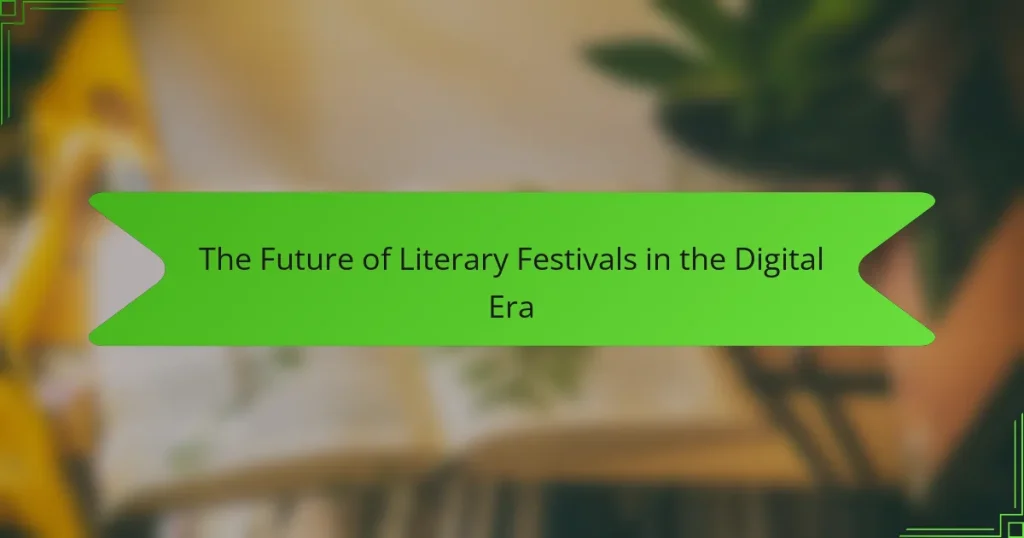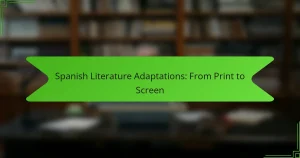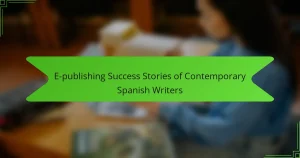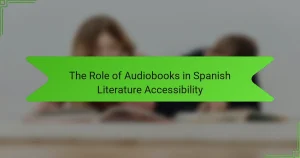The future of literary festivals hinges on their ability to adapt to digital transformation. Hybrid models are emerging, combining in-person experiences with virtual engagement. Festivals are leveraging live-streamed events, podcasts, and interactive workshops to enhance accessibility and reach global audiences. However, they face challenges in audience engagement and monetization, necessitating innovative approaches to sustain relevance in a changing landscape.
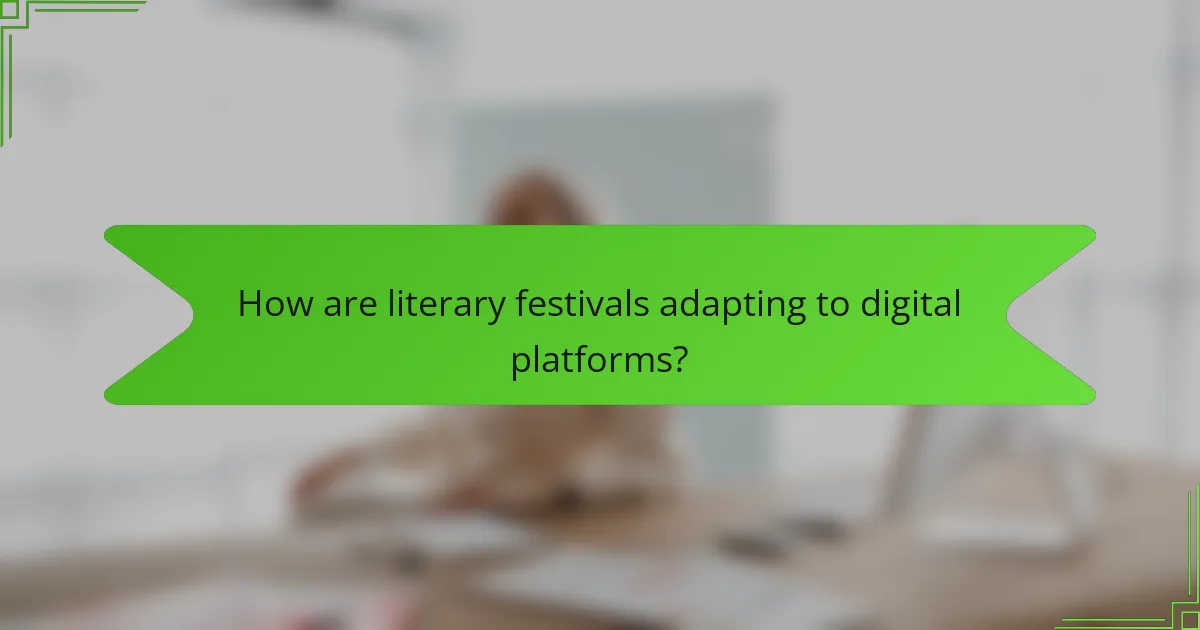
How are literary festivals adapting to digital platforms?
Literary festivals are increasingly embracing digital platforms to enhance accessibility and engagement. Virtual events allow broader participation, reaching audiences beyond geographical constraints.
Many festivals now offer live-streamed author talks, panel discussions, and workshops, enabling real-time interaction with audiences. For instance, the Edinburgh International Book Festival successfully transitioned online, attracting thousands of viewers globally.
Additionally, digital formats facilitate diverse content delivery, including podcasts and recorded sessions, which can be accessed on-demand. This flexibility caters to varying audience preferences, ensuring that literary discussions remain vibrant and inclusive.
As a result, the future of literary festivals appears to be a hybrid model, combining in-person experiences with digital innovation, ultimately enriching the literary community.
What are the main digital formats being utilized in literary festivals?
The main digital formats utilized in literary festivals include virtual panels, live-streamed readings, podcasts, e-books, and interactive online workshops. These formats enhance accessibility and engagement, allowing broader participation. Virtual panels enable real-time discussions, while live-streamed readings connect authors with audiences globally. Podcasts offer on-demand content, and e-books provide digital access to featured works. Interactive workshops foster community involvement and skill development.
How do virtual events compare to in-person experiences?
Virtual events provide accessibility and convenience, while in-person experiences foster personal connections. Each format offers unique attributes that enhance literary festivals. Virtual events allow global participation, reducing travel costs and time. In contrast, in-person events create immersive environments that encourage networking and spontaneous interactions. The choice between them depends on audience preferences and festival goals.
Which technologies are enhancing audience engagement at festivals?
Technologies enhancing audience engagement at festivals include augmented reality, live streaming, and interactive apps. These innovations create immersive experiences, allowing attendees to connect with authors and content in real-time.
Augmented reality offers unique visual experiences, enhancing book displays and author interactions. Live streaming enables remote participation, expanding audience reach beyond physical limits. Interactive apps facilitate real-time feedback and community building, fostering deeper connections among festival-goers.
As a result, these technologies are transforming literary festivals, making them more accessible and engaging for diverse audiences.
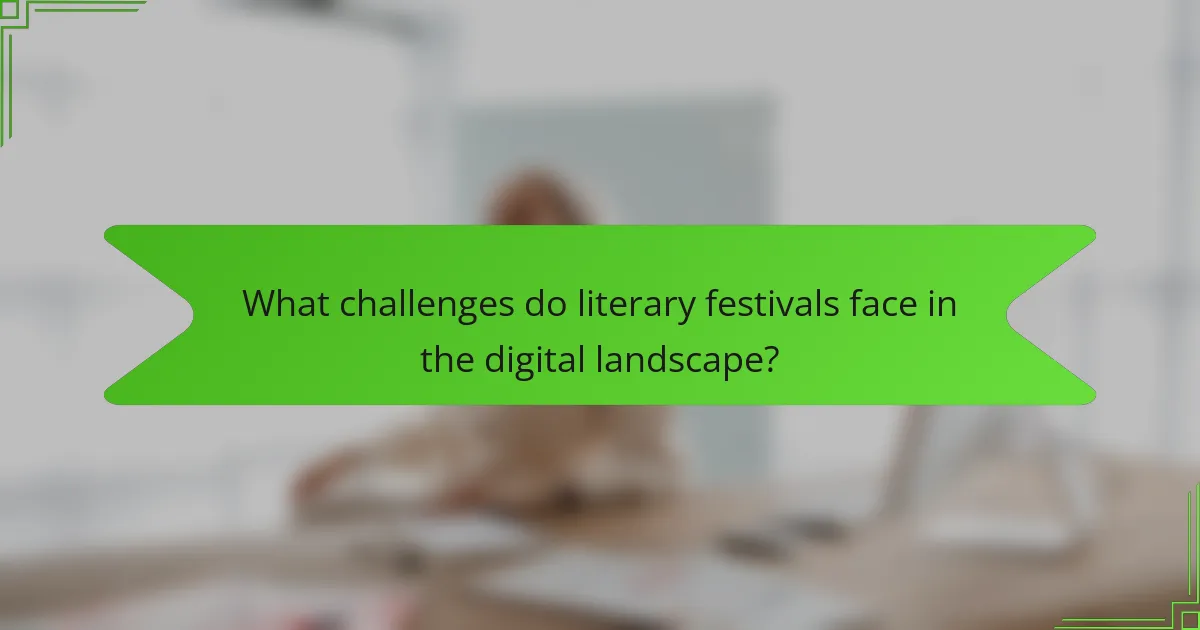
What challenges do literary festivals face in the digital landscape?
Literary festivals face significant challenges in the digital landscape, including competition from virtual events, audience engagement, and monetization. The rise of online platforms allows audiences to access literary content without attending festivals, reducing physical attendance. To counter this, festivals must innovate by enhancing online experiences and incorporating interactive elements. Additionally, securing funding and sponsorships has become more complex as traditional revenue streams shift. Adapting to these changes is crucial for the sustainability of literary festivals in the digital era.
How do funding and sponsorship models shift in a virtual context?
Funding and sponsorship models in virtual contexts prioritize digital engagement and audience reach. Traditional sponsorships are evolving to include virtual brand activations, social media partnerships, and online content collaborations. This shift allows literary festivals to attract a wider audience while providing sponsors with measurable engagement metrics. Additionally, innovative funding methods such as crowdfunding and virtual ticket sales are gaining traction, enabling festivals to sustain operations in a digital landscape.
What are the implications of digital accessibility for diverse audiences?
Digital accessibility enhances literary festivals by ensuring diverse audiences can engage fully. This inclusivity fosters wider participation, allowing people with disabilities or varying literacy levels to enjoy events. Accessible formats, such as audiobooks and sign language interpretation, cater to unique audience needs. As a result, festivals can reach broader demographics, increasing community engagement and support.
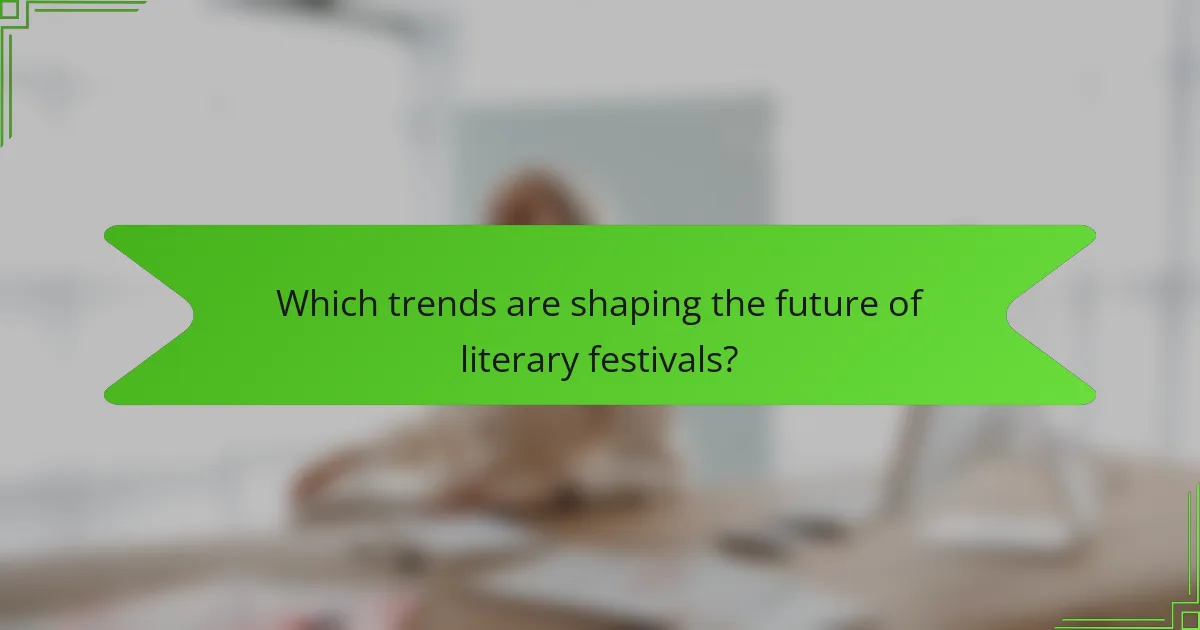
Which trends are shaping the future of literary festivals?
Digital innovation and audience engagement are key trends shaping the future of literary festivals. Virtual events expand reach, allowing global participation. Hybrid formats combine in-person and online experiences, enhancing accessibility. Social media amplifies visibility, fostering community interaction. Data analytics guide programming decisions, tailoring content to audience preferences. Sustainability initiatives address environmental concerns, promoting eco-friendly practices.
How is audience behavior changing in response to digital offerings?
Audience behavior is increasingly shifting towards digital engagement with literary festivals. Virtual events provide wider access, attracting diverse audiences who prefer convenience and flexibility.
This change reflects a growing trend where attendees value online interactions over traditional formats. For instance, surveys indicate that 70% of festival-goers now favor digital participation due to its accessibility.
Additionally, social media platforms enhance audience interaction, allowing real-time feedback and engagement with authors. This dynamic creates a more inclusive environment, fostering community building among literature enthusiasts.
As a result, literary festivals must adapt by integrating digital offerings to meet evolving audience preferences and expand their reach.
What role do social media and online communities play in festival promotion?
Social media and online communities significantly enhance festival promotion by expanding reach and engagement. They enable real-time interaction, allowing organizers to connect directly with audiences. Platforms like Facebook and Instagram provide tools for targeted advertising and event sharing, amplifying visibility. User-generated content fosters community involvement, creating a sense of belonging and anticipation around festivals. Additionally, online discussions and reviews can influence attendance, making social media a critical tool for shaping public perception and driving ticket sales.
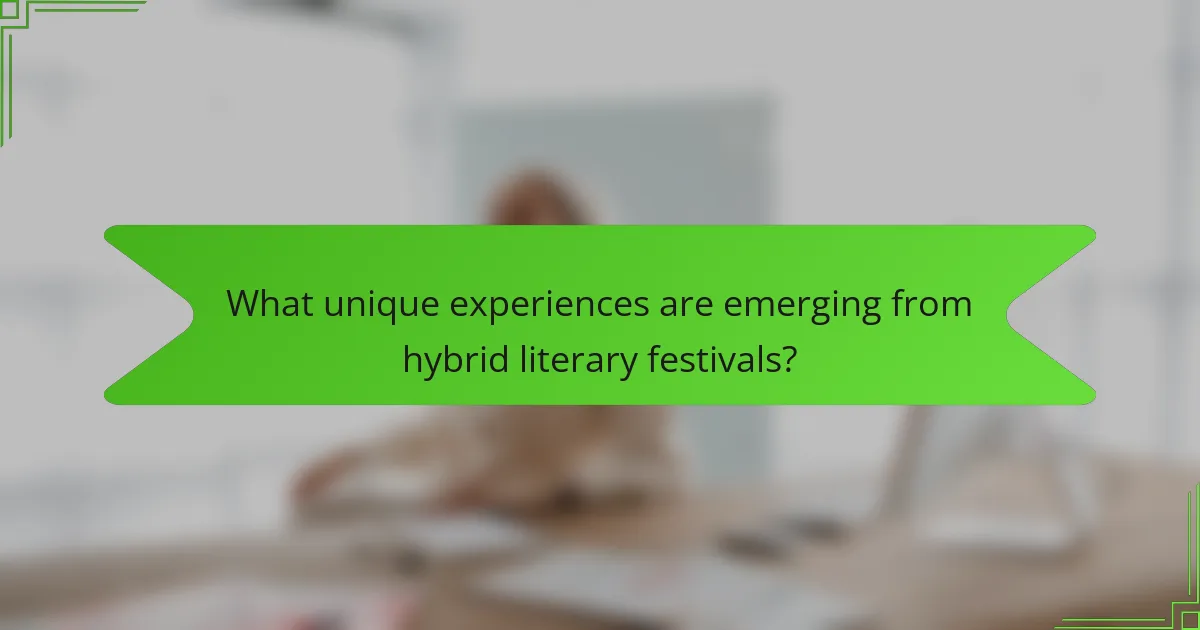
What unique experiences are emerging from hybrid literary festivals?
Hybrid literary festivals are creating unique experiences by blending in-person and virtual elements. This approach enhances accessibility, allowing global participation and diverse interactions. Attendees can engage with authors through live-streamed readings and Q&A sessions, fostering a sense of community despite geographical barriers. Additionally, these festivals often incorporate multimedia content, such as podcasts and interactive workshops, enriching the overall experience. The integration of technology also enables real-time feedback and discussions, which can lead to innovative literary collaborations.
How do hybrid events balance virtual and physical attendance?
Hybrid events effectively balance virtual and physical attendance by integrating both experiences seamlessly. This approach allows literary festivals to reach broader audiences while maintaining the intimacy of in-person interactions.
For instance, virtual platforms enable participation from remote attendees, offering live streaming and interactive sessions. This inclusion enhances audience engagement and diversifies attendance demographics.
Additionally, hybrid formats provide flexibility in scheduling, accommodating various time zones and preferences. As a result, literary festivals can adapt to audience needs while preserving essential elements of the physical experience, such as networking and author signings.
Ultimately, the future of literary festivals lies in leveraging technology to create inclusive, dynamic environments that cater to both physical and virtual participants.
What innovative programming is being introduced in hybrid formats?
Literary festivals are increasingly adopting hybrid formats that blend in-person and virtual experiences. This innovation enhances accessibility, allowing broader audiences to participate. For example, live-streamed author panels and interactive Q&A sessions engage remote attendees effectively. Additionally, these formats enable global participation, breaking geographical barriers. As a result, literary festivals can reach diverse audiences and foster inclusive dialogue around literature.
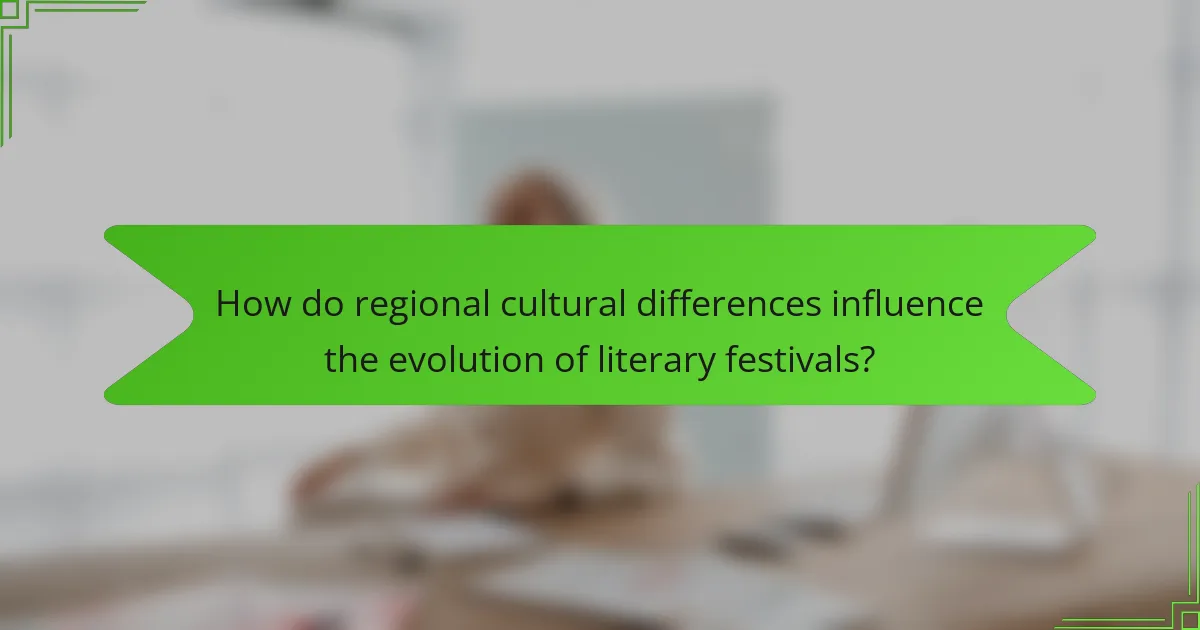
How do regional cultural differences influence the evolution of literary festivals?
Regional cultural differences significantly shape literary festivals’ evolution by influencing themes, audience engagement, and programming. Festivals often reflect local traditions and values, fostering unique literary expressions. For example, festivals in diverse regions showcase local authors, cultural narratives, and indigenous storytelling methods. This adaptability ensures relevance in a digital era, where global audiences seek authentic experiences. As a result, festivals increasingly incorporate digital platforms to broaden reach while preserving cultural uniqueness. Such integration enhances participation and promotes cross-cultural exchanges, vital for the future of literary festivals.
What are the key attributes of successful literary festivals in different regions?
Successful literary festivals in different regions prioritize community engagement, diverse programming, and digital integration. These attributes enhance accessibility and broaden audience reach.
Community engagement fosters local participation and collaboration, while diverse programming attracts varied demographics. Digital integration allows festivals to expand their audience beyond geographical limitations, offering virtual access to events and discussions.
For example, festivals in urban areas often feature a broader range of authors and genres, appealing to diverse interests. Conversely, rural festivals may focus on local authors and themes, creating a unique cultural experience.
As a result, successful festivals leverage these attributes to adapt to changing audience expectations in the digital era.
How do local authors and communities impact festival programming?
Local authors and communities significantly enhance festival programming by fostering unique cultural expressions and engaging local audiences. Their involvement ensures that events reflect regional identities and literary trends. Local authors often draw on community narratives, creating relatable content that resonates with attendees. This connection can lead to increased attendance and participation, as audiences feel a sense of ownership and pride in their local literary scene. Festivals that prioritize local talent often see a boost in community support, sponsorship, and volunteer engagement, making them more sustainable in the long run.
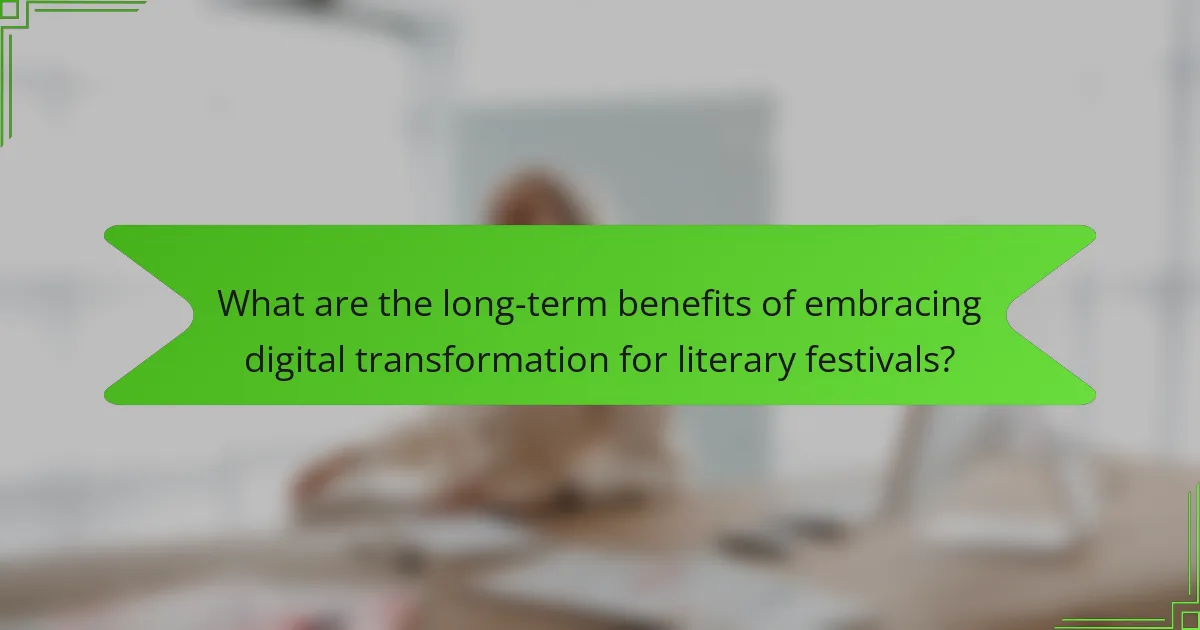
What are the long-term benefits of embracing digital transformation for literary festivals?
Embracing digital transformation offers long-term benefits for literary festivals, including increased audience engagement and broader reach. Digital platforms enable festivals to connect with global audiences, allowing for hybrid events that combine in-person and virtual experiences. Enhanced data analytics provide insights into attendee preferences, improving future programming. Additionally, digital tools facilitate collaboration among authors, publishers, and readers, fostering a vibrant literary community. Ultimately, these advancements ensure literary festivals remain relevant and accessible in an evolving cultural landscape.
How can data analytics improve festival planning and execution?
Data analytics can significantly enhance festival planning and execution by optimizing logistics, improving audience engagement, and personalizing experiences. By analyzing ticket sales data, organizers can predict attendance patterns, enabling better resource allocation. Audience feedback collected through surveys and social media can guide programming decisions, ensuring that events resonate with attendees. Additionally, data can identify trends in content preferences, allowing for tailored marketing strategies that boost participation. This data-driven approach ultimately leads to more successful and enjoyable literary festivals in the digital era.
What strategies can enhance audience retention in a digital-first environment?
Engaging audiences in a digital-first environment requires innovative strategies. Utilizing interactive elements, such as live Q&A sessions or polls, can significantly enhance audience retention. Personalized content recommendations based on user behavior can increase engagement levels. Additionally, creating community spaces for discussions fosters a sense of belonging, encouraging attendees to return. Regularly analyzing audience feedback helps refine strategies to meet evolving preferences.
What best practices should organizers adopt for future literary festivals?
Organizers should adopt innovative digital strategies, engage diverse audiences, and prioritize sustainability for future literary festivals. Utilizing virtual platforms enhances accessibility, while interactive sessions foster community engagement. Additionally, implementing eco-friendly practices can attract environmentally conscious attendees. Emphasizing these elements can shape successful literary festivals in the digital era.
